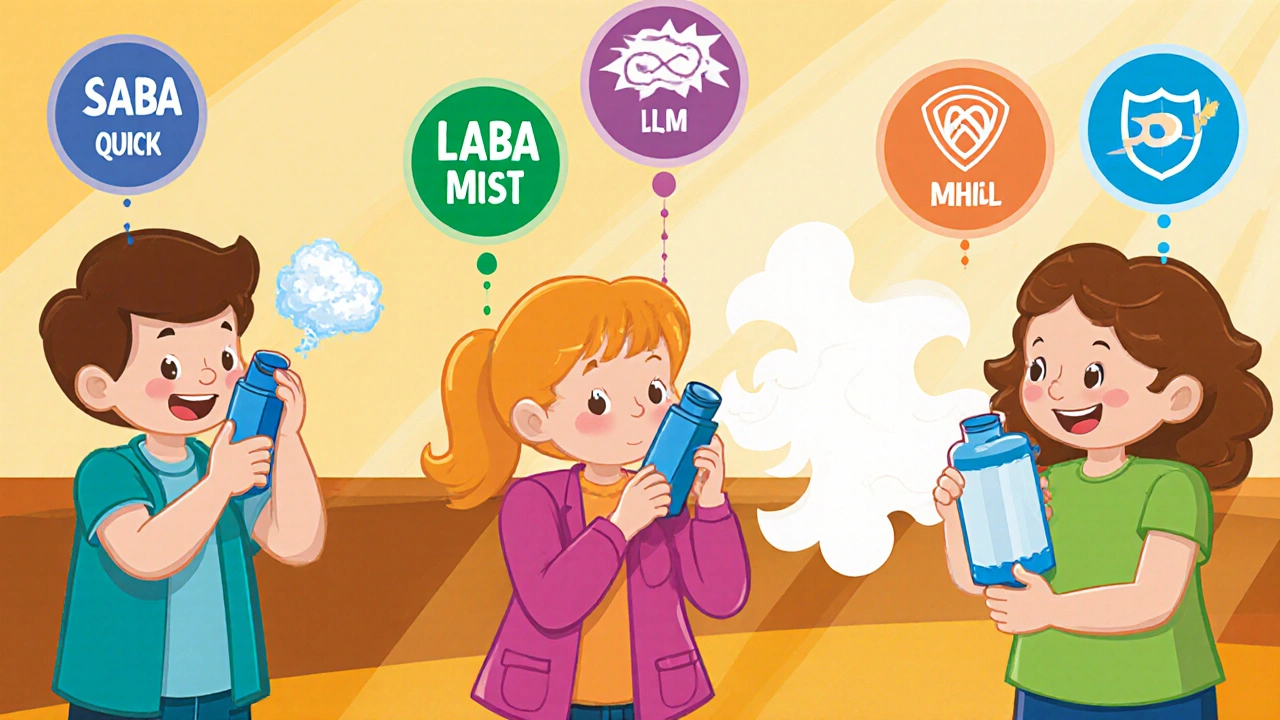COPD Bronchodilator Selection Tool
Your COPD Treatment Guide
Answer a few simple questions to identify the best bronchodilator approach for your COPD stage according to current GOLD guidelines.
Living with chronic obstructive pulmonary disease (COPD) means every breath can feel like a battle. The good news? Bronchodilators are the frontline weapons that open up the airways and make daily life manageable. This guide walks you through how they work, the different families you’ll encounter, and practical tips for picking and using the right inhaler.
Key Takeaways
- Bronchodilators relax airway muscles, easing airflow limitation in COPD.
- SABAs provide quick relief; LABAs and LAMAs are used for maintenance.
- Combination inhalers (LABA/LAMA) reduce pill burden and improve adherence.
- Proper inhaler technique and regular monitoring are essential for optimal control.
- Side‑effects differ by class; knowing them helps you and your clinician adjust therapy.
Bronchodilator is a medication that relaxes the smooth muscles surrounding the airways, allowing them to open wider and improve airflow. In COPD, the airways are chronically narrowed and inflamed, so using a bronchodilator can instantly relieve breathlessness and, over time, help maintain lung function.
How Bronchodilators Work in COPD
Airways contain smooth‑muscle fibers that tighten in response to irritants, inflammation, or certain hormones. When these muscles contract, the airway lumen shrinks, making exhalation difficult. Bronchodilators target specific receptors on these muscles:
- Beta‑2 adrenergic receptors - activation causes muscle relaxation (used by beta‑agonists).
- Muscarinic receptors - blockage prevents the constricting signal of acetylcholine (used by antimuscarinics).
By stimulating beta‑2 receptors or blocking muscarinic receptors, bronchodilators quickly widen the bronchi, reduce resistance, and improve oxygen delivery.
Major Classes of Bronchodilators Used in COPD
Not all bronchodilators are created equal. Below is a snapshot of the most common families, their typical duration, and when they’re prescribed.
| Class | Typical Onset | Duration of Action | Common Brand Examples | Primary Use |
|---|---|---|---|---|
| Short‑acting beta‑agonist (SABA) | Minutes | 4-6hrs | Albuterol, Levalbuterol | Rescue relief of acute breathlessness |
| Long‑acting beta‑agonist (LABA) | 15-30min | 12-24hrs | Salmeterol, Formoterol | Maintenance therapy for stable COPD |
| Long‑acting muscarinic antagonist (LAMA) | 30min | 24hrs | Tiotropium, Umeclidinium | Maintenance, especially in severe disease |
| Combination LABA/LAMA | 15-30min | 24hrs | Glycopyrrolate/Formoterol, Umeclidinium/Vilanterol | Enhanced maintenance for moderate‑to‑severe COPD |
Each class offers a distinct balance of speed and duration. The choice depends on symptom pattern, disease severity, and patient preference.
Choosing the Right Bronchodilator for Your COPD Stage
Guidelines (e.g., GOLD 2024) break COPD into four groups (A‑D) based on symptom burden and exacerbation risk. Here’s a quick map:
- Group A (low symptoms, low risk) - A SABA taken as needed may be enough.
- Group B (high symptoms, low risk) - Add a long‑acting agent (LABA or LAMA) for daily control.
- Group C (low symptoms, high risk) - A LAMA is preferred to prevent flare‑ups.
- Group D (high symptoms, high risk) - Combination LABA/LAMA or LABA/LAMA+inhaled corticosteroid if frequent exacerbations persist.
Beyond guidelines, clinicians weigh other factors:
- Inhaler type preference - Press‑air metered dose inhaler (MDI) vs. dry powder inhaler (DPI) vs. soft‑mist inhaler.
- Comorbidities - Beta‑agonists may raise heart rate; caution in arrhythmias.
- Cost and insurance coverage - Generic SABAs are cheap; some combination inhalers may need prior authorization.

Inhaler Devices: Which One Fits Your Lifestyle?
Even the best bronchodilator won’t help if it’s not delivered correctly. The main device categories are:
- Metered‑dose inhaler (MDI) - releases a fine spray; requires coordination with inhalation.
- Dry‑powder inhaler (DPI) - powder inhaled by a deep, rapid breath; no timing needed.
- Soft‑mist inhaler - produces a slow‑moving mist; easier for older adults.
Try a demo at your pharmacy: a clinician can watch your technique and suggest the device that feels most natural.
Proper Inhaler Technique - The Hidden Key to Success
Studies show up to 50% of patients use their inhaler incorrectly, squandering the drug’s benefits. Follow these steps for each device type:
MDI (with or without spacer)
- Shake the inhaler for 5seconds.
- Exhale fully, then place the mouthpiece between your teeth.
- Press down once while starting a slow, steady inhale.
- Hold your breath for 10seconds, then exhale gently.
DPI
- Load the dose (often a click).
- Exhale completely away from the device.
- Seal lips around the mouthpiece and inhale quickly and deeply.
- Hold breath for about 5seconds, then breathe out.
Soft‑mist
- Turn the device on (usually a button).
- Hold it upright, place it in your mouth, and breathe in slowly.
- Continue inhaling for several seconds to capture the mist.
- Close the device and exhale.
Repeat the steps for each puff, waiting 30seconds between doses if more than one is prescribed.
Monitoring Your Progress
Regular check‑ups keep therapy on track. Two practical tools are:
- Spirometry - measures forced expiratory volume (FEV1) and helps gauge disease progression.
- Modified Medical Research Council (mMRC) dyspnea scale - a quick questionnaire that quantifies breathlessness during daily activities.
When you notice a rise in rescue inhaler use (more than two puffs per day), increased cough, or a drop in FEV1, it’s time to revisit your regimen with your clinician.

Common Pitfalls and Safety Tips
Even seasoned patients slip up. Keep an eye on these issues:
- Over‑reliance on SABAs - Frequent rescue use can mask worsening disease.
- Duplicate therapy - Using two separate LABA inhalers instead of a single combo adds cost and confusion.
- Cardiovascular side‑effects - Beta‑agonists may cause tremor or rapid heart rate; report persistent palpitations.
- Dry mouth - Common with antimuscarinics; sip water or use sugar‑free gum.
- Device expiration - Inhalers lose potency after the printed date; replace on schedule.
Addressing these early prevents exacerbations and hospital visits.
Putting It All Together - A Sample Treatment Path
Imagine Jane, a 68‑year‑old former smoker with GOLD groupB COPD. Her doctor starts her on a once‑daily LAMA (tiotropium) via a soft‑mist inhaler for maintenance. She keeps an albuterol MDI for rescue, using it only when she feels sudden tightness.
After three months, Jane’s mMRC score drops from 3 to 2, and her rescue inhaler use falls to one puff per week. Spirometry shows stable FEV1. Because her symptoms are well‑controlled, the regimen stays unchanged.
If Jane’s breathlessness returned, the next step might be adding a LABA to create a LABA/LAMA combo, simplifying her routine.
Frequently Asked Questions
What’s the difference between a SABA and a LABA?
SABAs, like albuterol, start working in minutes and last 4-6hours, making them ideal for sudden flare‑ups. LABAs, such as salmeterol, take a bit longer to kick in (15-30minutes) but provide 12-24hours of relief, so they’re used daily to keep the lungs open.
Can I use a bronchodilator without a prescription?
In most countries, short‑acting bronchodilators are prescription‑only because misuse can hide worsening disease. Some over‑the‑counter (OTC) options exist abroad, but it’s safer to get a prescription and proper inhaler training.
Are combination inhalers always better than separate devices?
Combination inhalers simplify dosing and improve adherence, but they may not suit everyone. Some patients need a specific dose of a LAMA and a separate LABA for fine‑tuning, or they might have trouble with a larger inhaler device. Discuss options with your clinician.
How often should I replace my inhaler?
Most inhalers have a shelf life of 12-24months once opened. Check the expiration date on the canister, and replace it promptly to avoid reduced medication delivery.
What should I do if my rescue inhaler isn’t helping?
If symptoms persist after two puffs, that signals a COPD exacerbation. Call your healthcare provider immediately; you may need oral steroids, antibiotics, or a short course of additional bronchodilators.
Bronchodilators remain the cornerstone of COPD care. By understanding their types, matching them to disease severity, mastering inhaler technique, and staying vigilant about side‑effects, you can keep the lungs open and the quality of life high.


Emily (Emma) Majerus
October 17, 2025 AT 13:20Great rundown! Keep focusing on proper inhaler technique; it'll make a huge diff.
Virginia Dominguez Gonzales
October 18, 2025 AT 01:50Wow, reading this feels like watching a breath‑saving superhero movie! The way you broke down the quick‑acting vs. long‑acting bronchodilators is pure cinematic gold. I can already picture patients stepping onto the stage of their own lungs, inhaler in hand, ready to conquer the villainous breathlessness. Your tips on technique are the hidden super‑powers that turn an ordinary inhaler into a trusty sidekick. Keep shining that light; the COPD community needs this epic saga.
Carissa Padilha
October 18, 2025 AT 17:06The pharmaceutical giants don’t want you to know the full story behind bronchodilators. While they tout "quick relief" and "maintenance", they are quietly pushing you into a lifetime dependency on patented devices. Every puff you take is a tiny payment into their pocket, funding more research that keeps the next generation of inhalers locked behind insane prices. They also hide the fact that many of these compounds can interfere with heart rhythm, a side‑effect they downplay in the fine print. Think about the fact that the devices are often designed to be hard to clean, fostering bacterial growth that can trigger infections. And the so‑called "soft‑mist" inhalers? A clever marketing ploy to make you feel safe while they embed micro‑particles that can lodge deep in the bronchi. Do you ever wonder why the guidelines keep shifting, nudging you toward newer combo inhalers that cost double? It's a well‑orchestrated dance: doctors prescribe, patients obey, insurers pay, and the pharma conglomerate smiles. The real enemy isn’t the disease; it’s the profit‑driven machine that decides which breath you get to keep. If you truly want control, you have to question every label, every dosage, and every recommendation that comes from a boardroom, not a bedside. Only then can you reclaim your lungs from the hidden agenda. Consider the environmental impact of disposable inhaler canisters, another profit‑centric externality. The carbon footprint of propellants contributes to climate change, which in turn worsens respiratory illnesses. Patients are often left in the dark about these ecological costs. Transparency is the first step toward genuine empowerment. Until regulators enforce full disclosure, we remain pawns in a well‑masked enterprise.
Richard O'Callaghan
October 19, 2025 AT 05:36i think u r right just keep using the inhaler as you were told.
Katie Henry
October 19, 2025 AT 20:53Dear fellow respirators, it is my sincere pleasure to commend the thorough exposition presented herein. Your diligent elucidation of bronchodilator pharmacodynamics, coupled with practical inhaler stewardship, embodies the quintessence of patient‑centered care. May I urge each of you to persist in rehearsing the technique delineated, for consistency begets mastery. Let us also remain vigilant for adverse signals, reporting them promptly to our healthcare providers. Together, we shall navigate the vicissitudes of COPD with poise and confidence.
Chris Beck
October 20, 2025 AT 09:23Look mate this inhaler stuff is overhyped its just a puff of air thats it we need real solutions not more gadgets!! the government and pharma collab to keep us buying more and more dont you see!!
Sara Werb
October 21, 2025 AT 00:40Honestly, the whole inhaler regime is a staged drama orchestrated by hidden elites!!!! They tell us to click, inhale, repeat, while they watch from the shadows, counting our breaths like some twisted lottery!!!! The "soft‑mist" is just a vaporous distraction, a smoke screen for the real agenda!!!! Wake up, people, before the next patented puff locks you deeper into the system!!!!
Winston Bar
October 21, 2025 AT 13:10Well, if everyone’s going to act like it’s a conspiracy, I’ll just sit back and enjoy the show. More drama, less effort – perfect.